 |
An
early Ford 15cwt 4X4 with the second pattern (No.12) cab and 2B1 box.
The 15
cwt class of vehicle was the most common of the lighter trucks, coming
into British service in the early 1930s. With a relatively low profile
and an approximate 1 ton payload, these vehicles were common to every arm
and level of the military. Early trucks such as these were not fitted for
spare wheels/tyres, as they were equipped with runflat tyres. Later in
the war when rubber became a critical commodity, standard tubed pneumatic
tyres were substituted, and provision made for spares. This example sports
9.00 X 16 U.S. NDCC tyres as the originals are now impossible to come by. |
|
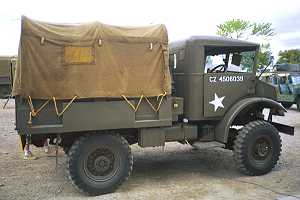 |
A
1944 Chev C15A with third pattern (No.13) cab and original canvas. With
a 101-inch wheelbase, these vehicles were quite agile and were used by
front-line units for resupply and general admin.
The crooked
invasion star painted on the door is representative of the unruly Canadians'
unwillingness to adopt wholesale a common U.S. symbol. |
|
 |
Another
view of the same vehicle. Note the U.S. NDCC tyres and the round roof hatch.
The latter was adopted in 1944 production; unlike the earlier square hatches,
this one was sealed by a piece of canvas. |
|
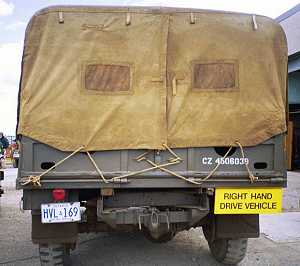 |
A
rear view, showing tailgate and canvas. The enthusiast will note that the
plastic windows on this tarp have been covered over; the tarp itself is
stamped and dated 1943. It was found covering a crate of machinery in a
company lot and bought for $15.00 CDN! Note the various concessions to
legality. |
|
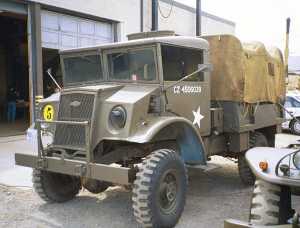 |
Front
Quarter view. The bridge class sign and blackout light are of original
configuration, and the mirrors are NOS. Powered by the standard 216ci Chev
straight-six OHV engine, the maximum speed for this wee beastie is only
40mph+ due to extreme final gearing. |
|
 |
A
good shot of the 2C1 box and spare tyre carrier. If anyone knows of any
of these carriers, please tell us! |
|
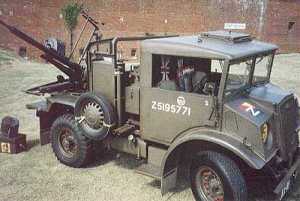 |
A
1943 Ford F15A equipped with a Polsten 20mm cannon. This particular vehicle
was found in a hedge in Great Britain, and was nine years in restoration.
Last summer it took all sorts of awards at Beltring. Truly unique! Congratulations
to Dave Ballard of Southampton, England for his perseverance. |
|
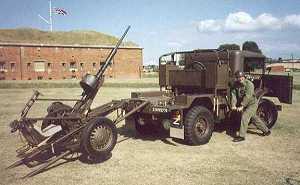 |
A
view of the Polsten unit being winched onto the bed of the truck. The cannon
could be deployed as left, or fired from the vehicle, as above. |
|
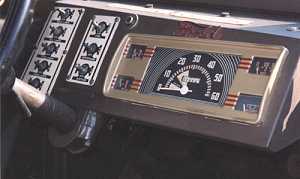 |
The
early instrument panel of the Polsten Ford. This modified commercial panel
was replaced in 1944 production with a series of standard U.S. round instruments. |
|
 |
Another
early panel, this time of a '43 Chev C15A. This vehicle was bought by Jim
Burrill of Pennsylvania in 1998, and is presently undergoing final restoration.
Look for more coverage on this vehicle shortly!
Note
that in this shot, the engine cover is off. |
|
 |
A
late-war Chev C15A Wireless Van. This vehicle would typically be used at
regimental and brigade level, equipped with an amplified 19-set and two
gasoline-driven chorehorses as well as advanced antenna gear. |
|
 |
A
fully-restored 12-cab Chev Water Truck photographed recently in Southern
Ontario. This particular example spent 30 years under cover at a volunteer
fire department and is probably the best surviving example in existence. |
|
 |
Left
rear view of same. Note the unique running board/fender arrangement, as
well as the stowage and roof bows. The 200-imperial gallon tank is baffled
inside to prevent surge. Standard equipment includes power take-off pump,
emergency hand pumps, filter unit, suction hose and water testing equipment. |
|
 |
Right
rear. Aside from the reflectors, the only integral part of the truck not
entirely original are the water taps themselves. Anyone know of a commercial
application which includes 'L'-shaped handles as opposed to the common
'T'-shaped handles? All in all, a unique vehicle! |
|
 |
Another
warrior awaits restoration somewhere in Western Canada... |
|
 11 Feb 00
11 Feb 00 |
Back to CMP Softskins |
|
Back to the FAT |
|
| Copyright ©
Geoff
Winnington-Ball , 1999-2000 All Rights Reserved |